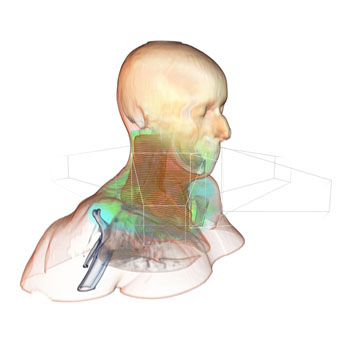New Algorithms Adjust Radiation Therapy During Treatment
By MedImaging International staff writers
Posted on 23 Jun 2016
A novel project will help to better calibrate radiation therapy (RT) treatment areas by shifting the initial computerized tomography (CT) images and correcting for different positions patients during sessions.Posted on 23 Jun 2016
Developed by researchers at the Fraunhofer Institute for Medical Image Computing (MEVIS; Bremen, Germany), the algorithms are part of the European software platform for adaptive multimodal radio and particle therapy with autarkic extendibility (SPARTA) initiative, which began in 2013 and ended in June 2016. The project included 10 collaborators across a variety of disciplines, including research institutes, medical technology companies, and university clinics.

Image: A simulated dose distribution of the radiation plan (Photo courtesy of MEVIS).
The MEVIS researchers developed algorithms that automatically align different images of the same patient, correcting for shifting positions patients assume during RT sessions. It also distorts and moves the images if necessary to align the structures, for example to display the lung precisely in different breathing phases. To help plan RT, the algorithm transfers the contours of the therapy plan derived from the initial CT to the current situation, using the image registration results of the current CT image. As a result, inaccurate contours ‘snap’ quickly into place.
The researchers also created a demonstrator tool to help clinicians visualize alternative RT plans, decide if the initial therapy plan is still accurate, and determine uncertainties that arise from patient motion during sessions, which can often last across several weeks of therapy. The three-dimensional (3D) models depict a series of images; the bigger the movements during irradiation, the blurrier the images are compared to the reference; these visualizations can help decide if the radiation plan should be readjusted or not. The separate elements can be relatively easily integrated into existing medical devices.
Currently, RT begins with a CT scan that shows the position of the tumor and the surrounding organs. Based on this image, a treatment plan indicates the number of radiation sessions, the radiation dosage, and the body areas to be treated. Conditions, however, can change during the course of therapy. The tumor shrinks and its form may change; weight loss may occur; and patients do not always assume the same position during RT sessions. In many cases, the initial distribution of the X-ray dose is no longer optimal and must be adjusted. This re-planning process can become very complex and time-consuming.
Related Links:
Fraunhofer Institute for Medical Image Computing














